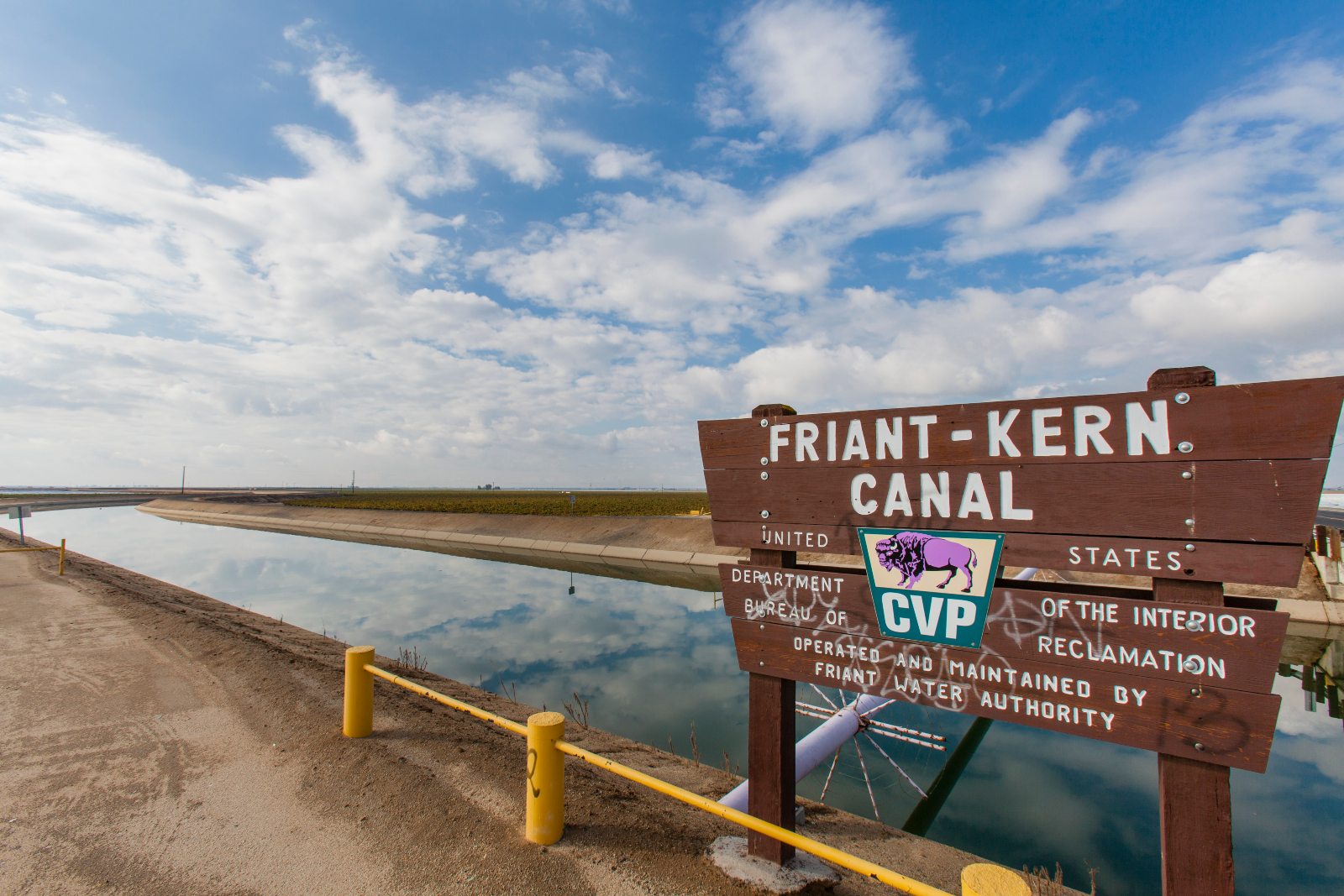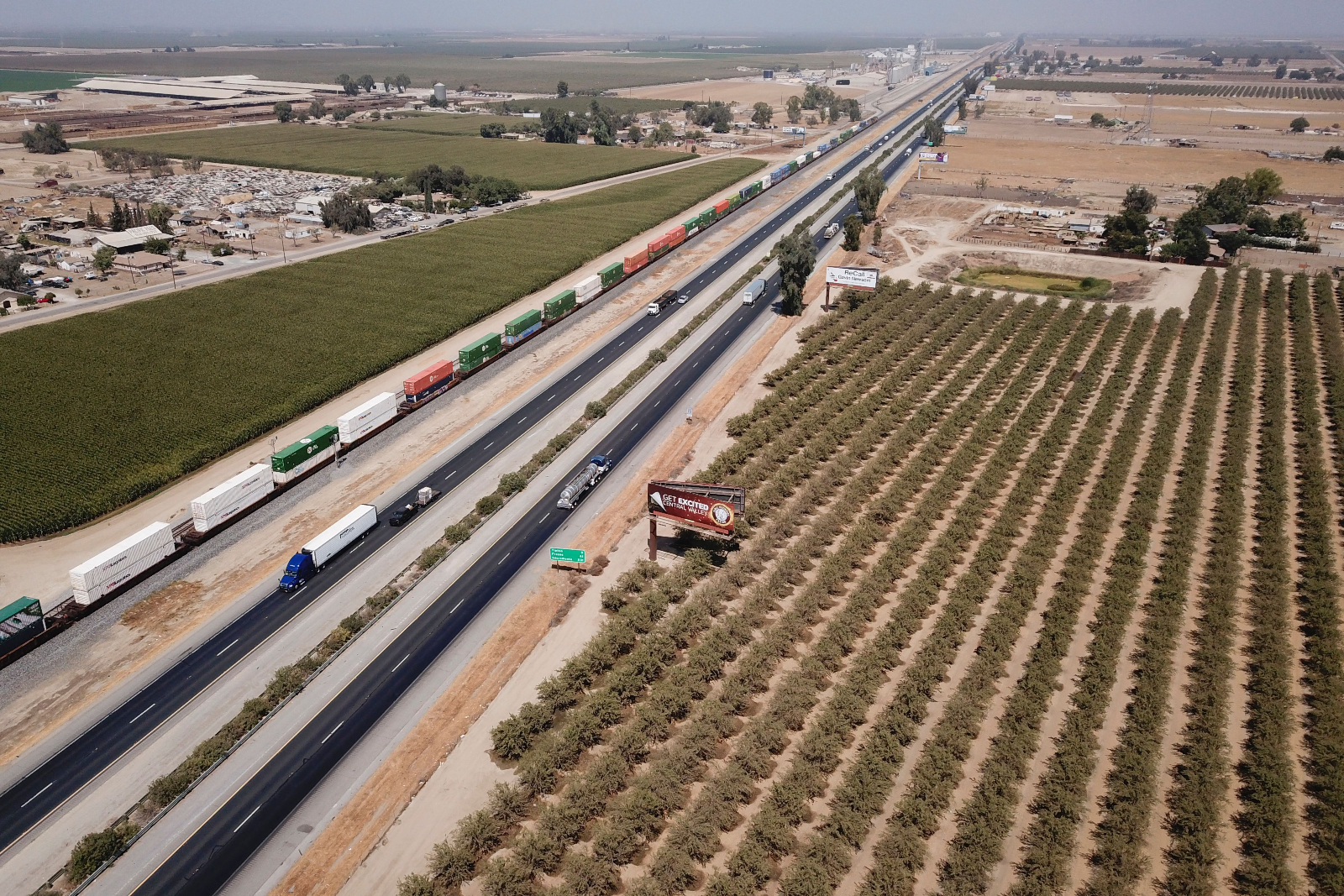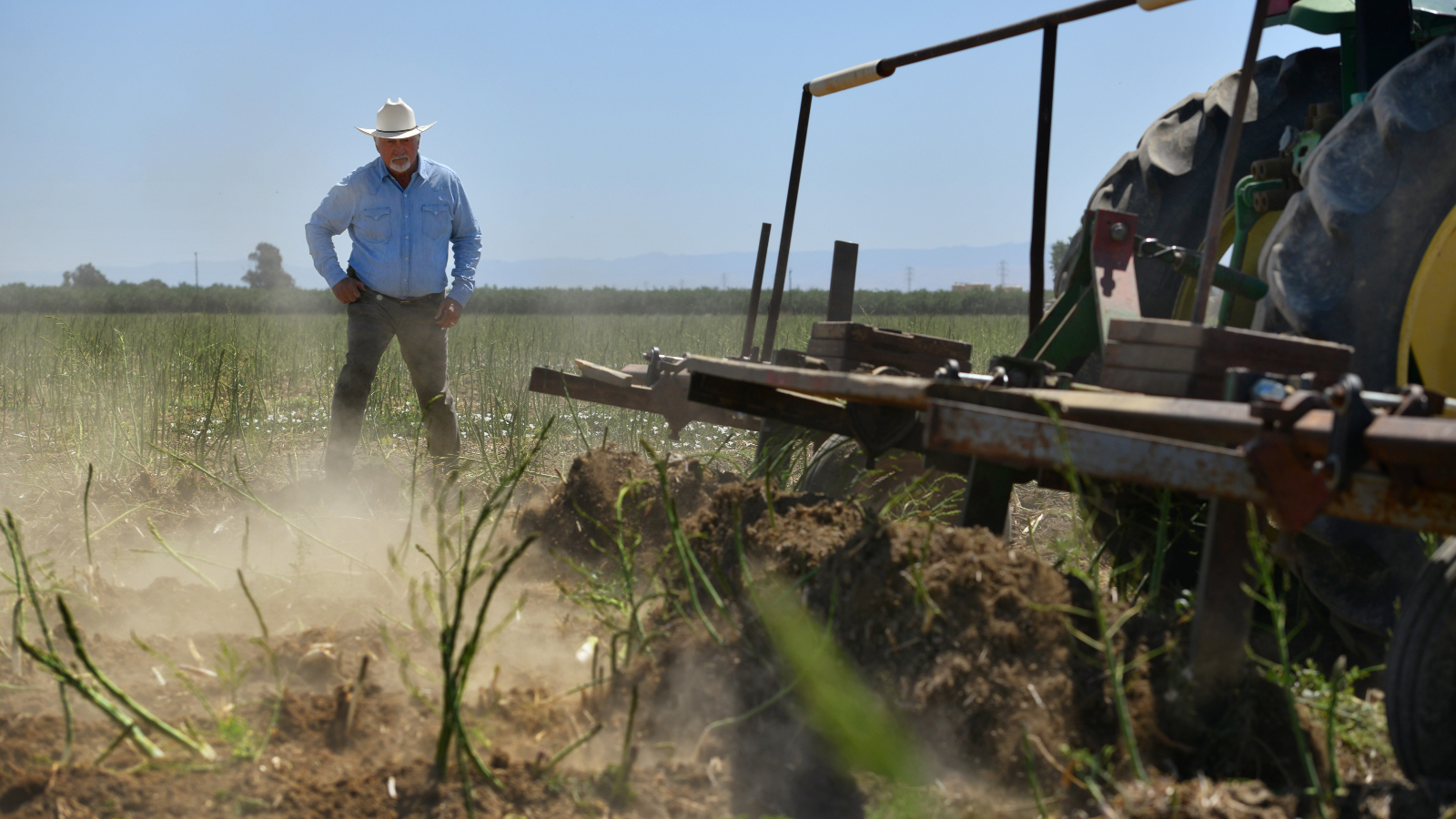This story is part of the Grist series Parched, an in-depth look at how climate change-fueled drought is reshaping communities, economies, and ecosystems.
This summer is not going to be easy for Matt Watkins. The 39-year-old farmer runs a citrus operation in Tulare County, on the southeast side of California’s Central Valley, and he irrigates his trees using water from a federal canal system. Earlier this year, the federal government informed farmers in his area that it would be delivering only 15 percent of a typical year’s water allotment, thanks to a severe regional drought that has sapped the reservoirs and rivers that are supposed to replenish the canals.
Watkins’s trees need regular watering over the course of the year in order to produce California’s famous oranges, but this summer the water from the federal canal will only last him a month. He and other nearby farmers are pumping unreliable groundwater to make up the difference, hoping their already struggling wells don’t go dry, or are purchasing water for exorbitant rates on an informal local market. Others will rip up their trees and leave their fields fallow.
“We’re year to year right now,” Watkins told Grist. “If it doesn’t rain next year, there could be a pretty big catastrophe for farming. It’s getting down to the point where there’s not much flexibility. There’s probably some small family farmers that may not survive completely.”
About 100 miles away, on the northwest side of the Central Valley, the situation could not be more different. Even during an unprecedented drought, the almond and pistachio farmers around the city of Los Banos will get around 75 percent of a normal year’s water, far more than almost any other group of growers in California. These farmers grow many of the same crops as the farmers on the southeast side, and the water they use comes from the same canal system. Yet while Watkins has almost no water, these farmers have plenty.
The startling contrast is the result of an obscure and contentious legal agreement known as the exchange contract, which dates back to the early twentieth century. This contract never mattered much during wet years, but during droughts it allows a small group of Central Valley farmers to claim enormous amounts of water while their neighbors make deep cuts. As the overall water shortage only deepens, the arcane legal precedent has pitted two groups of farmers against each other, opening up a rift in an industry that more often finds itself united in opposition to outside parties like environmentalists.
The aridification of the American West is straining the region’s antiquated water management system, draining reservoirs that have been full for decades and forcing the government to make new and painful decisions that privilege some groups at the expense of many others. Bigger water cuts could prove devastating for the Central Valley’s economy: A study of last year’s drought produced by the University of California, Merced, found that the water shortage caused $1.7 billion in economic losses and also resulted in the loss of more than 8,000 jobs, many of them among vulnerable migrant laborer populations. The effects aren’t limited to California. The Central Valley provides an enormous share of the nation’s fruits, vegetables, and nuts, and many of the crops are grown almost nowhere else in the country. If production continues to fall, there will be price impacts at grocery stores nationwide.
The exchange contract isn’t the source of these problems, but it does ensure that while most farmers struggle to make do with dramatically less water, a few will remain artificially insulated from the effects of climate change, which has enhanced the West’s ongoing megadrought — all thanks to water rights acquired generations earlier.
“We have a water rights system that is based on this principle of ‘first in time, first in right,’ where landowners were able to go out and post a sign on a tree and start diverting water. And just by the act of taking the water, it became theirs,” said Doug Obegi, director of California river restoration projects at the Natural Resources Defense Council.* “But that was only made available by the fact that the settlers had wiped the Native people off of the land. We have now a system that, a hundred-plus years later, is still maintaining that privilege, and leading to this inequity where you have some water districts getting very little water and others getting a lot.”
Officially, water rights in the U.S. operate on a principle of seniority. If you used a body of water first, you usually have a stronger legal claim to it than someone who started using it after you. This very simple principle can lead to some very complicated outcomes.
In the late nineteenth century, a California settler named Henry Miller built a cattle empire on the western side of the Central Valley, amassing over a million acres of land alongside the San Joaquin River. Miller and his partners claimed this land and used water from the San Joaquin to irrigate it, thus acquiring formal rights to the river water.
A few decades later, in the 1930s, the U.S. Bureau of Reclamation began building a series of dams and reservoirs in the mountains around the Central Valley. As in other parts of the West, the purpose of the dam system was to enable large-scale farming by creating massive water storage facilities. One of Reclamation’s goals was to redirect the San Joaquin River from the northern side of the valley to the drier southern side, diverting the flow of the river away from Miller’s cattle empire so it could irrigate more than a million acres of new farmland.

In order to redirect the river, Reclamation had to compensate the farmers who used Miller’s land, since they had formal rights to the water from San Joaquin River. The two parties worked out a unique deal: If the farmers surrendered their rights to the San Joaquin River, the government would provide them with an equal amount of water from another nearby river, the Sacramento.
If the Sacramento ever failed to provide the farmers with enough water, however, they could claim water from the San Joaquin, which was now flowing into the southern part of the valley. If the farmers on Miller’s land made such a claim, Reclamation would have to take the water away from the farmers in the southern part of the valley, move it through the canal system, and deliver it to the farmers on Miller’s land.
In other words, the farmers on Miller’s land had the rights to water from two different rivers, and they could cut ahead of other users in the event of a water shortage. These irrigators became known as the “exchange contractors,” and today they produce tens of thousands of acres’ worth of tomatoes, lettuce, pistachios, and almonds, making up a massive share of the Central Valley’s agricultural output. Their typical year’s water allocation is 875,000 acre-feet, equivalent to about half of Los Angeles County’s water supply.
For almost a century, the exchange agreement was just a hypothetical. That ended in 2014, during the start of California’s last major drought, when water levels dropped so low that Reclamation couldn’t provide any water to the exchange contractors. Pursuant to their original agreement with the federal government, the exchange contractors claimed their rights to water from San Joaquin, effectively seizing the water from farmers in the eastern part of the valley known as the Friant division, which is where Watkins has his citrus farm. The exchange contractors got a giant allocation of water, and the Friant farmers took a sizable cut, forcing them to pump groundwater or leave their crops unplanted. The same thing happened the next year.
In response to Reclamation’s decision, a group of water users led by the city of Fresno and several Friant irrigation districts filed a lawsuit against the federal government and the exchange contractors. The Friant districts alleged that, in fulfilling its contractual obligation to the exchange contractors, the federal government breached its contractual obligation to the Friant districts, failing to provide them with an adequate amount of water. After more than seven years, that lawsuit is still ongoing, though a decision is expected soon.
Meanwhile, California has entered the second year of another massive drought, and Reclamation has once again found itself between a rock and a hard place. While there is more water in the reservoir that flows to the Friant districts than there was last year, Reclamation is holding back that water so it can save it for the exchange contractors — for the third time in a decade.
This has created an almost surreal split-screen effect in the Central Valley. On the west side of the valley, in the irrigation districts that benefit from the exchange contract, farmers are proceeding more or less as they always have. On the east side of the valley, meanwhile, the situation is dire.

“The tension is palpable,” said Tricia Stever Blattler, the executive director of the Tulare County Farm Bureau, whose farmers rely on water from the Reclamation system. “A lot of farmers are fearing they will have to fallow ground and push trees and vines out. There’s speculation about selling land.”
Aaron Fukuda, the general manager of the Tulare Irrigation District, echoed that sentiment.
“The situation has become significantly worse as surface water deliveries are again curtailed this year, forcing growers to turn to groundwater,” he told Grist. In a typical dry year, many farmers can pump subterranean water from wells in order to make up for lost reservoir water, but that isn’t an option for many farmers in the area.
“Our groundwater levels have yet to recover from the last drought, so many [areas] are implementing groundwater cutbacks, which ultimately reduces the ability of growers to meet their crop demands,” he added. A state law passed during the last drought led to further restrictions on pumping, which leaves farmers in the valley with fewer options than ever.
The Natural Resources Defense Council’s Obegi says that the Bureau of Reclamation could soon push to renegotiate the exchange contract if it wanted to, potentially capping the water deliveries that go to the contractors and curbing degradation of the San Joaquin River in the process. The revision would be painful for the exchange contractors, but it would lead to a more equitable distribution of water in the valley during drought years. It would also help restore fish populations in the San Joaquin River, pursuant to a 2006 settlement in a lawsuit brought by environmental groups including the Natural Resources Defense Council.
Ernest Conant, the regional director for Reclamation’s mid-Pacific division, said the exchange contract is a reflection of Western water law, and that the authority is bound by law to honor the contract, even if it means diverting water from other parties.
“People may think this is just not fair,” he told Grist. “Why are the exchange contractors getting 75 percent and everybody else getting zero? The basic answer is, ‘first in time, first in right,’ and that’s the basic premise of water law throughout the West.”
Conant declined to comment on the specific details of how Reclamation interprets the exchange contract, citing the ongoing litigation. He did, however, say that the bureau might someday renegotiate the agreement.
Chris White, the executive director of the exchange contractors’ water authority, says the contractors are trying to minimize their impact on Friant farmers like Watkins, in part by using more groundwater and fallowing some land to ensure they don’t take more water from Friant than they need to. He blamed the diminished reliability of Reclamation’s water supply in part on regulation.
“When we first signed this contract, years and years ago, there was always a thought that Reclamation would be able to supply our water,” he said.
Fundamentally, the exchange contractors have no incentive to give up their water, and Reclamation has not made any attempts to get them to do so. Unless the Bureau pushes to renegotiate the contract, the two groups of farmers will likely remain at loggerheads.
That the two groups have been unable to come to a resolution is unusual, given that past water conflicts have generally pitted a united agricultural industry against non-agricultural water users. In other parts of California, the drought has caused tensions to erupt between farmers and Indigenous tribes, as Reclamation has held back water from farmers to preserve salmon populations. Along the Colorado River, meanwhile, recent cuts to Arizona’s water allocation have hit farmers first and worst while leaving municipal water intact. In the Central Valley, though, the shortage has redirected water from one group of farmers to another.
“It’s a tough situation,” said Alexandra Biering, the government affairs manager for the Friant Water Authority. “So many of the exchange contractors are our friends and good members of the agricultural community, which collectively always feels under attack. But this is really untenable.”
*Editor’s note: The Natural Resources Defense Council is an advertiser with Grist. Advertisers have no role in Grist’s editorial decisions.


